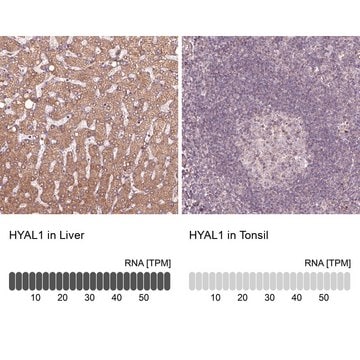H1136 is not supplied in solution form. The product is lyophilized directly into the ampule and its appearance is a clear, thin film.
H1136
Hyaluronidase from Streptomyces hyalurolyticus
Synonym(s):
Hyaluronate Lyase from Streptomyces hyalurolyticus
About This Item
Recommended Products
biological source
Streptomyces sp. (S. hyalurolyticus)
Quality Level
conjugate
conjugate (Glucosaminoglycan)
form
film (Clear)
packaging
ampule of 300 × units
storage temp.
−20°C
Looking for similar products? Visit Product Comparison Guide
General description
Application
- in the preparation of DMEM/F-12 (Dulbecco′s modified eagle medium/nutrient mixture F-12) media for the isolation and purification of single cells from dissociated tumour tissue[2]
- as a component of digestion solution for the derivation of germline stem cells from testicular tissue[3]
Biochem/physiol Actions
Unit Definition
Other Notes
Storage Class Code
11 - Combustible Solids
WGK
WGK 3
Flash Point(F)
Not applicable
Flash Point(C)
Not applicable
Personal Protective Equipment
Choose from one of the most recent versions:
Certificates of Analysis (COA)
Don't see the Right Version?
If you require a particular version, you can look up a specific certificate by the Lot or Batch number.
Already Own This Product?
Find documentation for the products that you have recently purchased in the Document Library.
Customers Also Viewed
Articles
Explore the role of hyaluronan, hyaluronic acid structure, hyaluronan synthesis & degradation, and more. Find GAGs, hydrogels, and scaffold kits.
Explore the role of hyaluronan, hyaluronic acid structure, hyaluronan synthesis & degradation, and more. Find GAGs, hydrogels, and scaffold kits.
Explore the role of hyaluronan, hyaluronic acid structure, hyaluronan synthesis & degradation, and more. Find GAGs, hydrogels, and scaffold kits.
Explore the role of hyaluronan, hyaluronic acid structure, hyaluronan synthesis & degradation, and more. Find GAGs, hydrogels, and scaffold kits.
Protocols
To measure hyaluronidase activity, a turbidimetric determination assay is used at 600 nm. One unit of hyaluronidase activity will cause a change in absorbance of 0.330 per minute at pH 5.35 at 37 °C.
To measure hyaluronidase activity, a turbidimetric determination assay is used at 600 nm. One unit of hyaluronidase activity will cause a change in absorbance of 0.330 per minute at pH 5.35 at 37 °C.
To measure hyaluronidase activity, a turbidimetric determination assay is used at 600 nm. One unit of hyaluronidase activity will cause a change in absorbance of 0.330 per minute at pH 5.35 at 37 °C.
To measure hyaluronidase activity, a turbidimetric determination assay is used at 600 nm. One unit of hyaluronidase activity will cause a change in absorbance of 0.330 per minute at pH 5.35 at 37 °C.
-
What is the volume in each vial/ampoule?
1 answer-
Helpful?
-
-
You mention the following buffer composition for reconstitution: "...20 mM sodium phosphate buffer, with 77 mM sodium chloride, 0.01% BSA, pH 7.0". If I want to refreeze aliquots, would you suggest the same buffer? Isn't sodium phosphate harmful here?
1 answer-
Long-term solution stability studies have not been performed on the microbial source hyaluronidase. However, the bovine source products are stable for up to 1 month at 4 deg. C (500 mM acetate buffer pH 6.0) and several months at - 20 deg. C. Aliquot solutions to store frozen, avoid repeated freeze/thaw cycles. The recommended reconstitution buffer should include 0.01% BSA which acts as a stabilizer, there is no indication that the recommended sodium phosphate/sodium chloride buffer would be inappropriate for freezing.
Helpful?
-
-
What is the molecular weight of Product H1136, Hyaluronidase?
1 answer-
The molecular weight for hyaluronidase from Streptomyces hyalurolyticus has been reported to be 91,000 DALTONS as determined by gel filtration.
Helpful?
-
-
How should Product H1136, Hyaluronidase, be reconstituted?
1 answer-
Prior to determining the activity of this enzyme, we reconstitute it in 20 mM sodium phosphate buffer, with 77 mM sodium chloride, 0.01% BSA, pH 7.0.
Helpful?
-
-
How is the activity of Product H1136, Hyaluronidase,determined?
1 answer-
Sigma assays the enzyme against a USP hyaluronidase reference standard as described in USP XXII-NF XVII, 644 (1990).
Helpful?
-
-
What amount of product is present in the vial of Product H1136, Hyaluronidase?
1 answer-
The dry weight of the product is not determined. The vial should contain a minimum of 300 units of enzyme.
Helpful?
-
-
I can't see any material in the container. Is material present in the container?
1 answer-
The product is lyophilized directly into the ampule and its appearance is a clear, thin film.
Helpful?
-
-
Are any other components present in Product H1136, Hyaluronidase, besides the enzyme?
1 answer-
No protein or BSA has been added as a stabilizer. The enzyme was lyophilized from 0.5 mM Tris buffer, pH 7.0.
Helpful?
-
-
What is the Department of Transportation shipping information for this product?
1 answer-
Transportation information can be found in Section 14 of the product's (M)SDS.To access the shipping information for this material, use the link on the product detail page for the product.
Helpful?
-
Active Filters
Our team of scientists has experience in all areas of research including Life Science, Material Science, Chemical Synthesis, Chromatography, Analytical and many others.
Contact Technical Service







